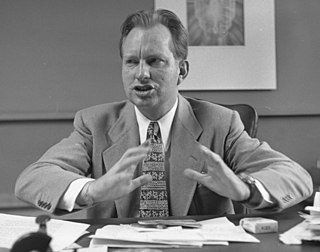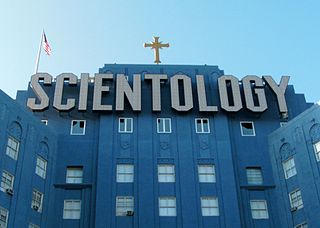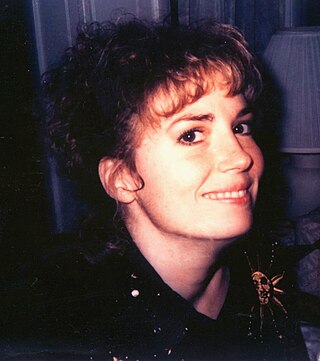
Dianetics is a set of pseudoscientific ideas and practices regarding the relationship between the human mind and body created by science fiction writer and Scientology founder L. Ron Hubbard. Dianetics is practiced by followers of Scientology and the Nation of Islam.

Lafayette Ronald Hubbard was an American author and the founder of Scientology. A prolific writer of pulp science fiction and fantasy novels in his early career, in 1950 he authored Dianetics: The Modern Science of Mental Health and established organizations to promote and practice Dianetics techniques. Hubbard created Scientology in 1952 after losing the intellectual rights to his literature on Dianetics in bankruptcy. He would lead the Church of Scientology, variously described as a cult, a new religious movement, or a business, until his death in 1986.

Xenu, also called Xemu, is a figure in the Church of Scientology's secret "Advanced Technology", a sacred and esoteric teaching. According to the "Technology", Xenu was the extraterrestrial ruler of a "Galactic Confederacy" who brought billions of his people to Earth in DC-8-like spacecraft 75 million years ago, stacked them around volcanoes, and killed them with hydrogen bombs. Official Scientology scriptures hold that the thetans of these aliens adhere to humans, causing spiritual harm.

In Scientology, the concept of the thetan is similar to the concept of self, or the spirit or soul as found in several belief systems. The term is derived from the Greek letter Θ, theta, which in Scientology beliefs represents "the source of life, or life itself." In Scientology it is believed that it is the thetan, not the central nervous system, which commands the body.

A body thetan or BT is a concept in Scientology of a disembodied thetan (being) that is stuck in, on, or near a human body. All human bodies are said to be infested by these disembodied thetans, or clusters of them.

The Purification Rundown, also known as the Purif or the Hubbard Method, is a pseudoscientific procedure that advocates of Scientology claim is a detoxification program. There is no evidence for its efficacy in detoxification, and significant evidence from clinicians that it is dangerous. It involves heat exposure for up to 5 hours a day and can exceed 4 weeks in length. It can potentially cause heatstroke damage, which includes brain injury, heart problems, organ failure, and death. It was developed by Scientology's founder L. Ron Hubbard and used by the Church of Scientology as an introductory service. Numerous individuals have been hospitalised as a result of taking part in the process.

The E-Meter is an electronic device used in Scientology that allegedly "registers emotional reactions". After claims by L. Ron Hubbard that the procedures of auditing, which used the E-Meter, could help heal diseases, the E-Meter became the subject of litigation. Since then, the Church of Scientology publishes disclaimers declaring that the E-Meter "by itself does nothing", is incapable of improving health, and is used solely for spiritual purposes.

Dianetics: The Modern Science of Mental Health, sometimes abbreviated as DMSMH, is a book by L. Ron Hubbard about Dianetics, a pseudoscientific system that he claimed to have developed from a combination of personal experience, basic principles of Eastern philosophy and the work of Sigmund Freud. The book is considered part of Scientology's canon. It is colloquially referred to by Scientologists as Book One. The book launched the movement, which later defined itself as a religion, in 1950. As of 2013, New Era Publications, the international publishing company of Hubbard's works, sells the book in English and in 50 other languages.

Suppressive person, often abbreviated SP, is a term used in Scientology to describe the "antisocial personalities" who, according to Scientology's founder L. Ron Hubbard, make up about 2.5% of the population. A statement on a Church of Scientology website describes this group as including notorious historic figures such as Adolf Hitler.

Since the founding of the Church of Scientology in 1954 by L. Ron Hubbard, the relationship between Scientology and psychiatry has been dominated by strong opposition by the organization against the medical specialty of psychiatry and of psychology with themes relating to this opposition occurring repeatedly throughout Scientology literature and doctrine. According to the Church of Scientology, psychiatry has a long history of improper and abusive care. The group's views have been disputed, criticized, and condemned by experts in the medical and scientific community and have been a source of public controversy.
Dianazene was the name given by L. Ron Hubbard to a vitamin compound containing iron, vitamin C, and various B vitamins, including especially large doses of niacin.
Sequoia University was an unaccredited higher education institution in Los Angeles, California, which acquired a reputation as a prolific "degree mill" selling degree certificates. Although it was shut down in 1984 by a court order, it is most notable today as the institution from which Scientology founder L. Ron Hubbard obtained an honorary "Doctorate of Philosophy" in the 1950s.

History of Dianetics and Scientology begins around 1950. During the late 1940s, L. Ron Hubbard began developing a mental therapy system which he called Dianetics. Hubbard had tried to interest the medical profession in his techniques, including the Gerontological Society, the Journal of the American Medical Association, and the American Journal of Psychiatry, but his work was rejected for not containing sufficient evidence of efficacy to be acceptable.
Para-Scientology is a branch of Scientology which deals with all things unknown.

Scientology: A History of Man is a book by L. Ron Hubbard, first published in 1952 under the title What to Audit by the Scientific Press of Phoenix. According to the author, it provides "a coldblooded and factual account of your last sixty trillion years." It has gone through many editions since its first publication and is a key text of the Church of Scientology. The book has been ridiculed by critics of Scientology for its unusual writing style and pseudoscientific claims; it has been described as "a slim pretense at scientific method ... blended with a strange amalgam of psychotherapy, mysticism and pure science fiction; mainly the latter."

This bibliography of Scientology includes Scientology and Dianetics-related books authored by L. Ron Hubbard and those produced by the Church of Scientology and its related organizations. Books compiled by the Church of Scientology and published after the death of Hubbard are usually indicated as "Based on the Works of L. Ron Hubbard". Books bearing L. Ron Hubbard's name are considered texts of Scientology's canon.
The amount of material on Dianetics and Scientology is extensive, to say the least. This material is composed of books by L. Ron Hubbard ; compilations of his works; taped lectures; auditor training materials ; course packages; booklets; a large number of magazines and annuals; and video recordings of the major annual events.

Clear Body, Clear Mind is a Scientology book compiled from L. Ron Hubbard material from the 1960s, which was published posthumously in 1990 by Bridge Publications, the Church of Scientology's publishing house. The book is considered part of Scientology's canon. It is the textbook for the Purification Rundown ("Purif"), which Scientologists believe is a detoxification program with medical and spiritual benefits, but has been criticized as pseudoscientific by medical professionals who have called it "dangerous", "quackery," and "in some cases lethal".

L. Ron Hubbard, Messiah or Madman? is a posthumous biography of Scientology founder L. Ron Hubbard written by Bent Corydon, which makes extensive use of interviews he conducted with Hubbard's son Ronald DeWolf. Though originally published in 1987 by Lyle Stuart Inc., the book was re-issued in a paperback edition on July 25, 1992, and a hardcover edition in October 1995, both by publisher Barricade Books. The 1995 edition also featured Brian Ambry as principal researcher. The first edition of the book listed DeWolf as coauthor.
L. Ron Hubbard used the term incident in a specific context for auditing in Scientology and Dianetics: the description of space operatic events in the Universe's distant past, involving alien interventions in past lives. It is a basic belief of Scientology that a human being is an immortal spiritual being, termed a thetan, trapped on planet Earth in a "meat body".

Scientology is in part derived from, and shares elements with, a number of esoteric or occult systems. The extent of the influence of specific occult belief systems on Scientology is a subject of debate amongst scholars.









